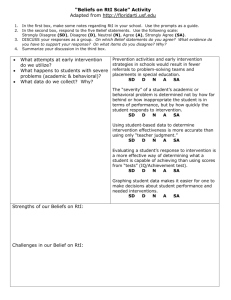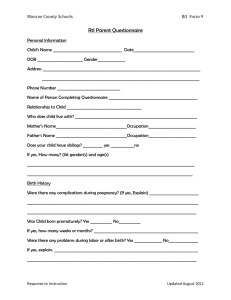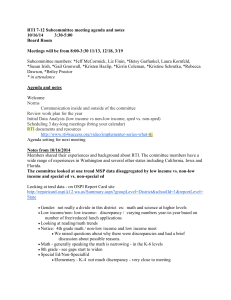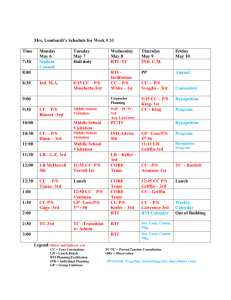Annotated Bibliography
advertisement
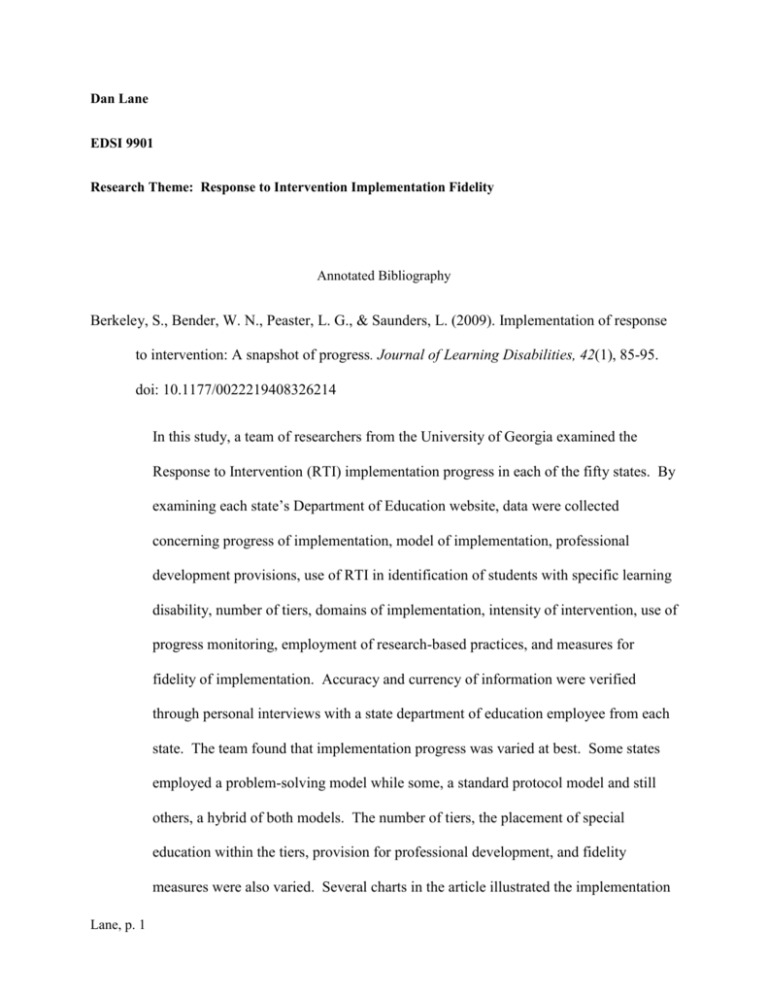
Dan Lane EDSI 9901 Research Theme: Response to Intervention Implementation Fidelity Annotated Bibliography Berkeley, S., Bender, W. N., Peaster, L. G., & Saunders, L. (2009). Implementation of response to intervention: A snapshot of progress. Journal of Learning Disabilities, 42(1), 85-95. doi: 10.1177/0022219408326214 In this study, a team of researchers from the University of Georgia examined the Response to Intervention (RTI) implementation progress in each of the fifty states. By examining each state’s Department of Education website, data were collected concerning progress of implementation, model of implementation, professional development provisions, use of RTI in identification of students with specific learning disability, number of tiers, domains of implementation, intensity of intervention, use of progress monitoring, employment of research-based practices, and measures for fidelity of implementation. Accuracy and currency of information were verified through personal interviews with a state department of education employee from each state. The team found that implementation progress was varied at best. Some states employed a problem-solving model while some, a standard protocol model and still others, a hybrid of both models. The number of tiers, the placement of special education within the tiers, provision for professional development, and fidelity measures were also varied. Several charts in the article illustrated the implementation Lane, p. 1 process for each state. Especially relevant to my study was the absence of information collected concerning RTI implementation at the secondary school level. The team noted that little empirical data existed supporting RTI implementation at the secondary school level even though some states used RTI as the only allowable identification process for students with specific learning disability. Bronzo, W. G. (2009). Response to intervention or responsive instruction? Challenges and possibilities of response to intervention for adolescent literacy. Journal of Adolescent & Adult Literacy, 53(4), 277-281. Retrieved from http://onlinelibrary.wiley.com/journal/10.1002/%28ISSN%291936-2706 In this commentary, the author posed three questions as to the validity in using Response to Intervention as the model to address literacy issues in middle school and high school students. Specifically he questioned whether RTI is a feasible structure for adolescent literacy, if RTI is the most effective model for developing a comprehensive secondary literacy program, and if RTI can provide responsive literacy instruction for all students. The author did not specifically answer the questions, but rather presented collective research to encourage the reader to form his/her own opinion. Noting the lack of research on the topic as well as the structural challenges faced by secondary schools in RTI implementation, the researcher pointed out that because RTI places emphasis on scientific-based interventions, that some non-research based strategies that are proven effective with secondary school students would be overlooked if RTI is used exclusively. Touting the preventative nature of RTI, he also noted that for the preventative nature to be effective that general classroom teachers Lane, p. 2 (content area specialists at the middle and high school) would also have to be literacy specialists, which in most cases, they are not. Danielson, L., Doolittle, J., & Bradley, R. (2007). Professional development, capacity building, and research needs: Critical issues for response to intervention implementation. School Psychology Review, 36(4), 632-637. Retrieved from http://www.nasponline.org/publications/spr/index-list.aspx The authors of this article are three employees of the Office of Special Education Programs in the US Department of Education. They comment on several critical issues needed for successful implementation of RTI in local schools. For RTI to be effectively implemented, teachers and administrators must be trained specifically in administering evidenced-based interventions. The authors cite several examples where the administration of such interventions was lacking. The authors also submit that capacity building for administrators and teachers in how to implement an RTI program must be included in a successful implementation plan. They conclude the article by citing several ideas for future research including how to provide interventions in a multi-tiered system, efficacy in progress monitoring, administration of evidence-based assessments, and implementation fidelity of all of these components. They also assert that very little research has been completed focusing on RTI beyond the 4th grade. Fuchs, D., & Fuchs, L. S. (2006). Introduction to response to intervention: What, why, and how valid is it? Reading Research Quarterly, 41(1), 93-99. Retrieved from http://www.reading.org/general/publications/journals/rrq.aspx Lane, p. 3 Published by a husband and wife research team at Vanderbilt University, this article exposes several problems with traditional implementation of RTI in American schools. They begin the article by outlining the basic tenets of RTI in order to provide for the reader a clear understanding of the guidelines so that that an understanding of the limitations of the process is made visible. Once the foundation is set, the authors compare and contrast two widely accepted implementation models of RTI, the problem solving model and the standard protocol model. Though they admit that most practitioners seem to prefer the problem solving model, they warn that this approach is generally less evidence-based (as RTI required) and less rigorous which could lead to incorrect labeling of students (i.e. false positives: some students labeled learning disabled that are not). Preferred by researchers, the standard protocol model evaluates all students using the same interventions so that a more reliable result can be compiled and cut-off scores delineated. As special education educators, the research team provides a unique view of RTI, less through the therapy for at-risk students lens and more through the identification process for learning disability lens. Fuchs, D., & Deshler, D. D. (2007). What we need to know about responsiveness to intervention (and shouldn’t be afraid to ask). Learning Disabilities Research & Practice, 22(2), 129136. doi: 10.1111/j.1540-5826.2007.00237 In this article, Fuchs and Deshler react to a statement made by David Tilly that “practitioners have all the necessary and sufficient information to conduct RTI competently.” The authors of the article disagree with Tilly’s statement and set out to illustrate all that is unknown about RTI and its successful implementation. With no intent to disparage the RTI process, the author’s point is to draw attention to the Lane, p. 4 unknowns so that future research could work to answer the unknown questions. Each subheading in the article is a question in need of answer followed by empirical data supporting the lack of knowledge on the issue. Questions raised include: what is RTI, what is the nature of Tier I instruction, what is meant by scientifically-based instruction, how are responders and non-responders identified, and what is “problem solving” and how does it address learning issues? Interestingly, the authors report a study where the same group of students was tested for learning disability identification using two different methods and both identification methods produced a different group of learning disabled students. Fuchs, L. S., & Fuchs, D. (2006). A framework for building capacity for responsiveness to intervention. School Psychology Review, 35, 621-626. Retrieved from http://www.nasponline.org/publications/spr/index-list.aspx In this commentary article, husband and wife team Doug and Lynn Fuchs provide a conceptual framework for RTI implementation. Acknowledging the challenges and unanswered questions associated with implementing RTI at all levels, they propose a framework for practitioners to consider when designing and implementing an RTI plan for a school. For each tier of intervention, questions are posed for consideration that have the potential to focus the designer on the salient aspects of RTI design. The article also includes brief commentaries on other articles present in the same special issue of School Psychology Review that deal with RTI and its effective implementation. Based on their commentary, I will seek this entire issue as a resource for my research since it seems to be a treasure-trove of RTI research. Lane, p. 5 Kavale, K. A. (2005). Identifying specific learning disability: Is responsiveness to intervention the answer? Journal of Learning Disabilities, 38(6), 553-562. Retrieved from http://ldx.sagepub.com/ Kavale, a professor of special education at Regent University, seems to refute the work of Fuchs, Fuchs, and Vaughn in this article concerning using RTI as an identification criterion for specific learning disability (SLD). Currently replacing the discrepancy model for SLD designation in many states, RTI is being used to assign the SLD label to students who are nonresponsive to scientific-based interventions. Kavale points out that the major problem with the discrepancy model was not that it promoted a “waiting to fail” before assigning a special education label (as proposed by Fuchs, Fuchs, and Vaughn), but that the discrepancy model was in many cases incorrectly applied. Kavale points out the shortcomings of the RTI model in the lack of definition in what non-responsiveness means. The lack of empirical definition leads to false positives and false negatives, he contends. He also suggests that many researchers, Fuchs, Fuchs, and Vaughn included, use the SLD designation interchangeably with the Reading Disabled (RD) designation, but that the two designations are different. Instead of using RTI exclusively, he recommends a redefinition and clarification of the SLD label such as was applied to mental retardation (MR) and emotional behavior disorder (EBD) in recent years along with using RTI as the first step towards identification. With a clarified definition, the discrepancy model would be an effective tool for identifying students with SLD. Mastropieri, M. A., & Scruggs, T. E. (2005). Feasibility and consequences of response to intervention: Examination of the issues and scientific evidence as a model for the Lane, p. 6 identification of individuals with learning disabilities. Journal of Learning Disabilities, 38, 525-531. Retrieved from http://ldx.sagepub.com/ In response to a paper presented by M. Gerber at the National Research Center on Learning Disabilities Responsiveness-to-Intervention Symposium, the two researchers, professors at George Mason University, discuss the limitations of using RTI as an alternative method of identification of students with a learning disability, and they propose a new standard for LD determination. The authors respond to five questions proposed by Gerber in his paper, and instead of answering them, expand on the ambiguities that are present in the RTI model. Questions concerning the changing role of teachers and diagnosticians, responsibility for implementation (general or special education), challenges at the middle or high school level, issues of consistency across schools, systems, and states, and differentiation of LD from other exceptionalities are explored. The article ends with an alternative method for identifying students with LD that incorporates RTI-type interventions at Tiers 1 and 2 with the traditional discrepancy model as the final determinant of the disability. Mellard, D. F., McKnight, M., & Woods, K. (2009). Response to intervention screening in 41 local schools. Learning Disabilities Research & Practice, 24(4), 186-195. doi: 10.1111/j.1540-5826.2009.00292 Three researchers from the University of Kansas completed a study of 41 elementary schools in order to assimilate how those 41 schools use screening, progress monitoring, and diagnostic assessment in their implementation of RTI. Mainly affluent schools meeting the criteria of seven benchmarks established by Mellard, Lane, p. 7 Byrd, Johnson, Tollefson, and Boesche (2004) were surveyed to establish their practices regarding universal screening, progress monitoring, and diagnostic assessments particularly at the Tier 1 (standards-based instruction), 2 (general intervention), and 3 (intense intervention) levels. They found that even though the schools met the criteria for possessing a viable RTI program, much variability existed in the frequency, depth, and efficacy of implementation. While most schools reported the inclusion of these components of RTI, the instruments used, the frequency of screening, and the intervals for progress monitoring varied greatly. At the Tier 2 and Tier 3 level, the researcher presented an exemplar school that showed, in their opinion, the most efficacious implementation of their RTI program. Telzrow, C. F., McNamara, K., & Hollinger, C. L. (2000). Fidelity of problem-solving implementation and relationship to school performance. School Psychology Review, 29(3), 443-461. Retrieved from http://www.nasponline.org/publications/spr/indexlist.aspx In this precursor article to the RTI initiative, the research team completed a quantitative study to determine the fidelity of implementation of intervention-based assessments (IBAs) performed by multidisciplinary teams (MDAs), the problemsolving framework frequently used in contemporary response to intervention practices. Though RTI is not mentioned specifically in this article from the year 2000, the same fidelity issues associated with the problem-solving construct associated with RTI are prevalent in this study. Surprisingly, many of the researchers cited in this article are the same researchers prolific in later writings on RTI. For this study, 227 MDTs were approved by the Ohio Department of Education for participation in the study in which Lane, p. 8 two types of instruments were used in order to assess fidelity. MDT-created Problem Solving Worksheets and Evaluation Team Reports were evaluated by specially trained psychologists using a standardized measure. Researcher-created surveys using a Lickert scale were also used to assess the fidelity of problem solving implementation. The researchers found only modest correlation of implementation in six of the eight assessed problem-solving components with student outcomes leaving room for further study of the efficacy of problem-solving methods. I will use this study to provide historical context for the problems with RTI implementation even before RTI was a well-known educational term. Lane, p. 9

